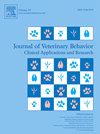Behavioral traits of rescue dogs from Southern and Eastern Europe rehomed to Germany
IF 1.3
3区 农林科学
Q4 BEHAVIORAL SCIENCES
Journal of Veterinary Behavior-clinical Applications and Research
Pub Date : 2025-01-01
DOI:10.1016/j.jveb.2025.01.005
引用次数: 0
Abstract
Over the past twenty years, dogs from Southern and Eastern Europe have been increasingly frequently rehomed to Germany and other Western European countries by animal welfare organizations. The aim of this study was to assess behavior and temperament of these dogs using the Canine Behavioral Assessment and Research Questionnaire (C-BARQ©) and to compare them with dogs from Western Europe. The study shows that foreign rescue dogs can be suitable pets and owners are often satisfied with their behavior. They show differences in all behavior scores. The greatest difference was found for ‘excitability’, which was lower in the non-Western European dogs. They also showed significantly higher scores for ‘non-social fear’ and ‘stranger-directed fear’, with Eastern European dogs scoring higher than Southern European dogs. Due to the study’s limitations (e.g. different median age, limited information on the dog’s origin in the native group, owner-derived behavioral information) the comparison is impaired and further investigation is required. While Southern dogs are more prone to chasing, Eastern European dogs display more ‘stranger-directed aggression’. Dogs that grew up in shelters are more trainable than stray dogs, but also have higher ‘stranger-directed fear’. Dogs that were less than one year old at the time of transport scored higher in ‘trainability’. Overall, the number of dogs with severe behavioral disorders was 6.7% for anxiety, 2.1% for aggression and 3.4% for abnormal repetitive behaviors. These dogs are considered to be enormously welfare compromised. In conclusion, dogs from Southern and Eastern Europe can be rehomed as pets if carefully selected and prepared.
求助全文
约1分钟内获得全文
求助全文
来源期刊
CiteScore
3.50
自引率
16.70%
发文量
107
审稿时长
325 days
期刊介绍:
Journal of Veterinary Behavior: Clinical Applications and Research is an international journal that focuses on all aspects of veterinary behavioral medicine, with a particular emphasis on clinical applications and research. Articles cover such topics as basic research involving normal signaling or social behaviors, welfare and/or housing issues, molecular or quantitative genetics, and applied behavioral issues (eg, working dogs) that may have implications for clinical interest or assessment.
JVEB is the official journal of the Australian Veterinary Behaviour Interest Group, the British Veterinary Behaviour Association, Gesellschaft fr Tierverhaltensmedizin und Therapie, the International Working Dog Breeding Association, the Pet Professional Guild, the Association Veterinaire Suisse pour la Medecine Comportementale, and The American Veterinary Society of Animal Behavior.

 求助内容:
求助内容: 应助结果提醒方式:
应助结果提醒方式:


